All That You Need to Know About Sales Commissions in 2025
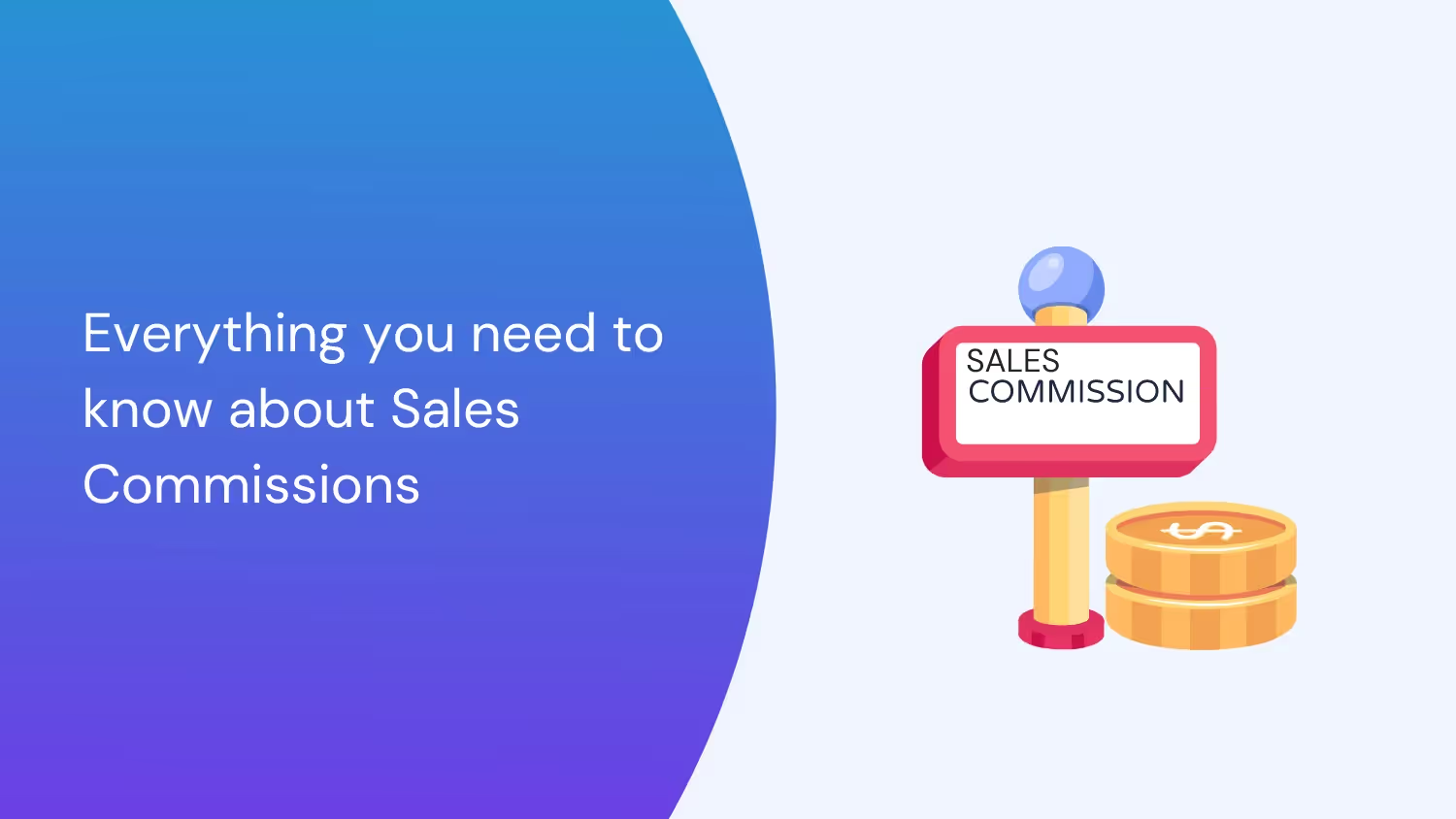
Imagine running a race with no finish line, no timer, and no reward.
That’s what a sales job feels like without the right commission structure. Confusing. Frustrating. Unsustainable.
Sales commissions aren’t just part of the paycheck. They’re the pulse of your revenue engine. When done right, they don’t just pay people — they drive behavior, build trust, and turn potential into performance.
But here's the uncomfortable truth: most companies still treat commissions as an afterthought. A number on a spreadsheet. A static percentage copied from last year’s plan.
And that’s where things break.
Quotas go unmet. Reps disengage. Finance teams scramble to fix errors. Leadership is left wondering: “Why aren’t we growing faster?”
In 2025, that approach won’t cut it.
Sales has changed. The best reps want clarity. The best leaders want control. Everyone wants fairness — and no one wants another clawback surprise three quarters in.
This guide is here to change how you think about commissions — not as a cost center, but as a competitive advantage.
Whether you're a founder building your first sales team, a RevOps leader reworking messy spreadsheets, or a CFO trying to make peace with ASC 606 — this is your blueprint.
We’ll unpack:
- What sales commissions really are (and aren’t)
- How to choose the right structure for your business
- How to calculate, benchmark, automate, and optimize them
- What tools, terms, and traps to know about
- And how to turn your commission plan into a magnet for top talent
This isn’t just another blog.
It’s the complete playbook — with strategy, structure, examples, and clarity. Written for people who don’t want the fluff — just results.
Let’s get into it.
What is Sales Commission? (And Why It’s More Than Just a Percentage)
At its core, sales commission is a financial incentive tied to performance — a reward that sales reps earn based on the deals they close or the revenue they generate.
Simple enough, right?
But don’t be fooled by the simplicity. Behind every commission check is a signal — a message to your team about what matters most.
Close big logos? Upsell? Retain clients? Chase net-new revenue?
Whatever you reward, you reinforce. That’s why commission for sales reps is not just compensation. It’s communication.
🔄 The Commission Loop: Motivation → Action → Revenue → Reward

Done right, commissions create a flywheel:
- Reps are clear on what’s expected
- They’re motivated to achieve it
- You hit revenue goals
- They get paid
- And they want to do it again
Done wrong, they create chaos:
- Confusion over targets
- Distrust in payouts
- Shadow accounting by reps
- And eventually, churn
Commission is where company strategy meets human behavior. It turns a spreadsheet formula into real-world outcomes.
👥 It’s Personal — and That’s the Point
For a CFO, commission is a cost to control.
For a rep, it’s a sign of respect.
A rep’s commission plan is more than a policy — it’s a promise.
“You do this, we’ll do that.”
And in today’s talent market, broken promises come at a high cost.
Reps won’t just leave — they’ll leave loudly.
Here’s an example from Reddit:

💡 Think of Commission Like a GPS, Not Just a Reward
It doesn’t just congratulate reps when they arrive. It guides them on where to go — and how fast to get there.
So before you start thinking about rates or tiers or clawbacks, ask yourself:
“What behavior are we trying to drive?”
Because your commission plan will drive it. One way or another.
What Is a Sales Commission Plan? (And Why Most Fail Without One)
A sales commission plan is the blueprint behind every payout.
It defines how commissions are calculated, when they’re paid, what qualifies as eligible, and who gets rewarded — and for what. But more importantly, it’s the operating system for your revenue team’s motivation.
Think of it this way:
If commission is the “what,” the plan is the “how,” “when,” and “why.”
And if you don’t get the plan right, even the most generous commission rates can backfire.
🧱 Anatomy of a Sales Commission Plan
A well-structured commission plan answers these questions before your reps ask them in Slack.
✅ 1. Commission Rate
The percentage (or fixed amount) a rep earns per sale.
This could be:
- Flat (e.g., 10% per deal)
- Tiered (e.g., 8% up to quota, 12% after)
- Based on gross margin or revenue
🧾 2. Payment Frequency
How often commissions are paid out — monthly, quarterly, or per deal.
Timing can influence cash flow, motivation, and accounting.
🎯 3. Quota & Targets
The minimum performance threshold to start earning.
Reps often need to hit quota before accelerators kick in.
📋 4. Qualifying Criteria
What actually counts? Closed-won deals? Signed contracts? Paid invoices?
This definition alone can make or break trust with reps.
📈 5. Accelerators & Decelerators
- Accelerators reward overperformance (e.g., 15% commission for 120%+ quota attainment)
- Decelerators penalize underperformance
They turn static plans into dynamic motivators — if structured right.
🔁 6. Clawbacks & Adjustments
What happens if a deal cancels, churns, or refunds?
Without clear clawback rules, your books — and trust — fall apart.
🚫 7. Caps (if any)
Some plans cap commissions to control costs.
But be warned: caps can demotivate your top performers fast.
🧭 What Makes a Commission Plan “Good”?
It’s not about generosity. It’s about alignment.
A great plan aligns:
- Company goals with rep behaviors
- Finance controls with sales flexibility
- Short-term wins with long-term growth
Here’s the litmus test:
Can every rep explain their plan in 90 seconds — without needing a spreadsheet?
If not, it’s too complex.
👉 Check out: What Is a Sales Commission Plan: A Deep Dive
Sales Commission Structures — Choosing the Right Model for Your Sales Motion
No two sales teams are the same.
So why use the same commission structure?
Your commission structure is how you pay — not just how much. It shapes rep behavior, signals priorities, and protects your bottom line.
A good structure motivates.
A great one scales.
Let’s break down the five most widely used models, when to use them, and how they influence performance.
💼 1. Commission Only — Pure Performance Pay
What it is: 100% variable income. Reps earn only what they sell.
Best for:
- Real estate, insurance, auto dealerships
- Gig-style or entrepreneurial roles
- High-margin transactional sales
Why it works:
- Low risk for the company
- High upside for top performers
- Attracts reps who thrive on autonomy
Trade-offs:
- No income stability = rep churn risk
- Can lead to aggressive or short-sighted selling
- Requires strong pipeline + product-market fit
💸 2. Base Salary + Commission — The SaaS Standard
What it is: A fixed base + commission (often 50/50 or 60/40 split)
Best for:
- Enterprise and B2B SaaS
- Long sales cycles
- High-touch consultative selling
Why it works:
- Balances security and incentive
- Enables coaching and ramp periods
- Supports team-based selling
Trade-offs:
- Higher fixed cost
- Risk of overpaying underperformers
- Needs clear quota setting and performance tracking
📶 3. Tiered Commission — Climb the Ladder, Earn More
What it is: Higher commission rates as reps cross defined thresholds
Example:
- 6% up to $50K revenue
- 8% from $50K–$100K
- 10% above $100K
Best for:
- SaaS subscriptions
- Advertising sales
- Companies with stretch targets
Why it works:
- Drives quota overachievement
- Encourages consistent pipeline building
- Recognizes incremental effort
Trade-offs:
- Can be gamed (sandbagging to next period)
- Needs clean data to track breakpoints accurately
🔁 4. Residual Commission — Earn As Clients Stay
What it is: Reps continue earning as long as a client keeps paying
Best for:
- Subscription businesses
- Membership services
- High-LTV product categories
Why it works:
- Incentivizes retention and post-sale care
- Rewards reps for acquiring the right customers
- Builds predictable income for reps
Trade-offs:
- Can be expensive over time
- Needs guardrails (e.g., residuals for 12–24 months max)
- Complexity increases with contract changes
📊 5. Gross Margin Commission — Profit Over Volume
What it is: Commission is a % of gross profit, not revenue
Best for:
- Wholesale, manufacturing
- Custom solutions or project-based sales
Why it works:
- Aligns reps with profitability, not just top-line
- Discourages deep discounting
- Supports better deal qualification
Trade-offs:
- Complex to calculate and explain
- Needs finance integration to track margins accurately
- Can demotivate reps if margins are inconsistent
⚖️ Choosing the Right Structure
Ask these 3 questions:
- What's your sales motion? (Transactional vs. consultative)
- What do you want to incentivize? (Volume, margin, retention?)
- What’s your rep profile? (Hunters vs. farmers, junior vs. strategic)
You don’t have to choose just one.
Hybrid plans (e.g., base + tiered commission with a margin floor) are often the most effective — if you keep them simple and explainable.
👉 For more info read: Top 10 Most Effective SaaS Sales Commission Structures
How to Calculate Sales Commission — Formulas, Examples, and Mistakes to Avoid
Let’s get one thing straight: calculating commissions isn’t hard because the math is difficult.
It’s hard because there’s more than one “right” way to do it — and if your reps don’t trust the logic, no formula will fix the fallout.
Whether you’re in SaaS, services, or B2B tech, understanding the what, how, and when of commission math is mission-critical.
Let’s break it down.
🧮 The Basic Formula
For most teams, the base formula looks like this:
Commission = Sale Amount × Commission Rate
Example:
A rep closes a $50,000 deal with a 10% commission rate.
Their payout = $5,000.
Sounds simple? It is — until you start adding real-world complexity.
📉 What’s the “Sale Amount,” Really?
Here’s where many teams slip.
Depending on your plan, “sale amount” might mean:
- Total contract value (TCV)
- Annual contract value (ACV) — common in SaaS
- Monthly recurring revenue (MRR) × term
- First payment only (especially for residual models)
- Gross margin, not revenue
Define this clearly and upfront. Ambiguity here = confusion + disputes later.
📊 SaaS-Specific Variables to Watch
SaaS sales introduce unique challenges in commission calculation.
Let’s unpack them:
1. Ramp Periods
New reps might be on a ramp-up quota — meaning their commission accelerators or thresholds may be adjusted.
2. Multi-Year Deals
Should reps earn on full TCV upfront? Or only on the first-year value?
Pro tip: Many teams pay on first-year ACV at close and the rest on renewal. It aligns revenue recognition with commission expense.
3. Discounted Deals
Don’t let reps sandbag margins. Apply commission after discounting — or base it on net revenue.
4. Renewals & Upsells
Decide early: Do reps earn the same rate for renewals? What about upsells from CS or AMs?
5. Refunds & Churn (Clawbacks)
If a customer cancels mid-term, do you recover paid commissions? Most SaaS orgs use a clawback window (e.g., 90 days from sale).
💥 Common Mistakes in Commission Calculations (And How to Avoid Them)
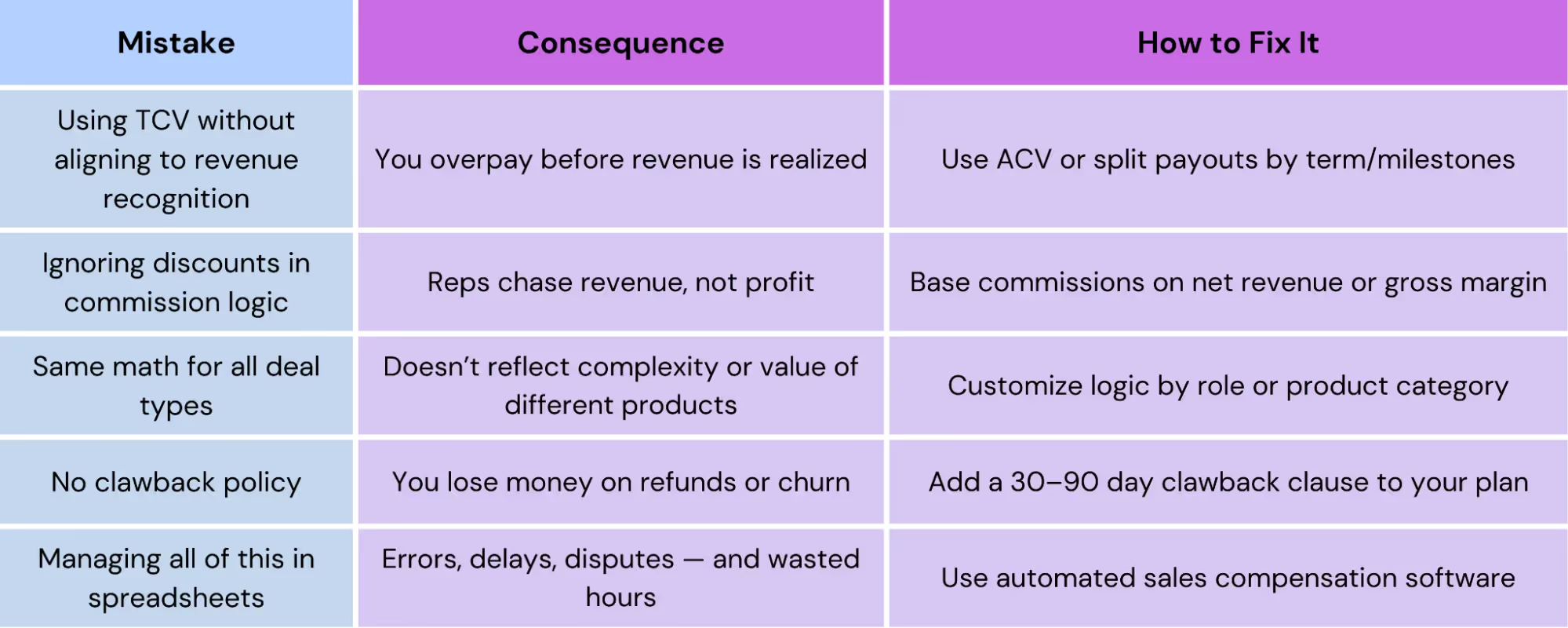
🛠️ Automate the Math, Build the Trust — Why Software Changes the Game
Let’s be honest: tracking commissions manually is a slow-moving disaster.
Especially when:
- Deals span quarters
- Plans vary by rep
- Clawbacks depend on churn
- Finance, sales, and legal all need a say
This is where purpose-built sales commission platforms like Visdum make a real difference.
With Visdum, you can:
- Set up custom rules for different plans and roles
- Track commissions in real time, synced with your CRM
- Manage ramp-ups, accelerators, and clawbacks — all in one place
- Give reps clear dashboards so they trust what they earn
- Align with ASC 606 without spreadsheets and stress
👉 Book a personalized demo with Visdum
No more Friday-night commission calculations.
No more “Why is my payout lower this month?” Slack messages.
No more finger-pointing between RevOps and Finance.
Just clarity, confidence, and control.
👉 Explore Visdum’s commission automation features
Sales Commission Rates — Benchmarks by Industry and Role
Let’s address the most Googled, most debated, and most misunderstood question in sales compensation:
“What’s a fair commission rate?”
The truth is, there’s no universal answer. A 10% commission could be too low for one company and too generous for another — it all depends on your industry, margins, role complexity, and sales cycle.
But benchmarks help. They give you a range, a reality check, and a conversation starter with leadership, finance, or your comp committee.
Let’s break it down.
📊 Average Commission Rates by Industry
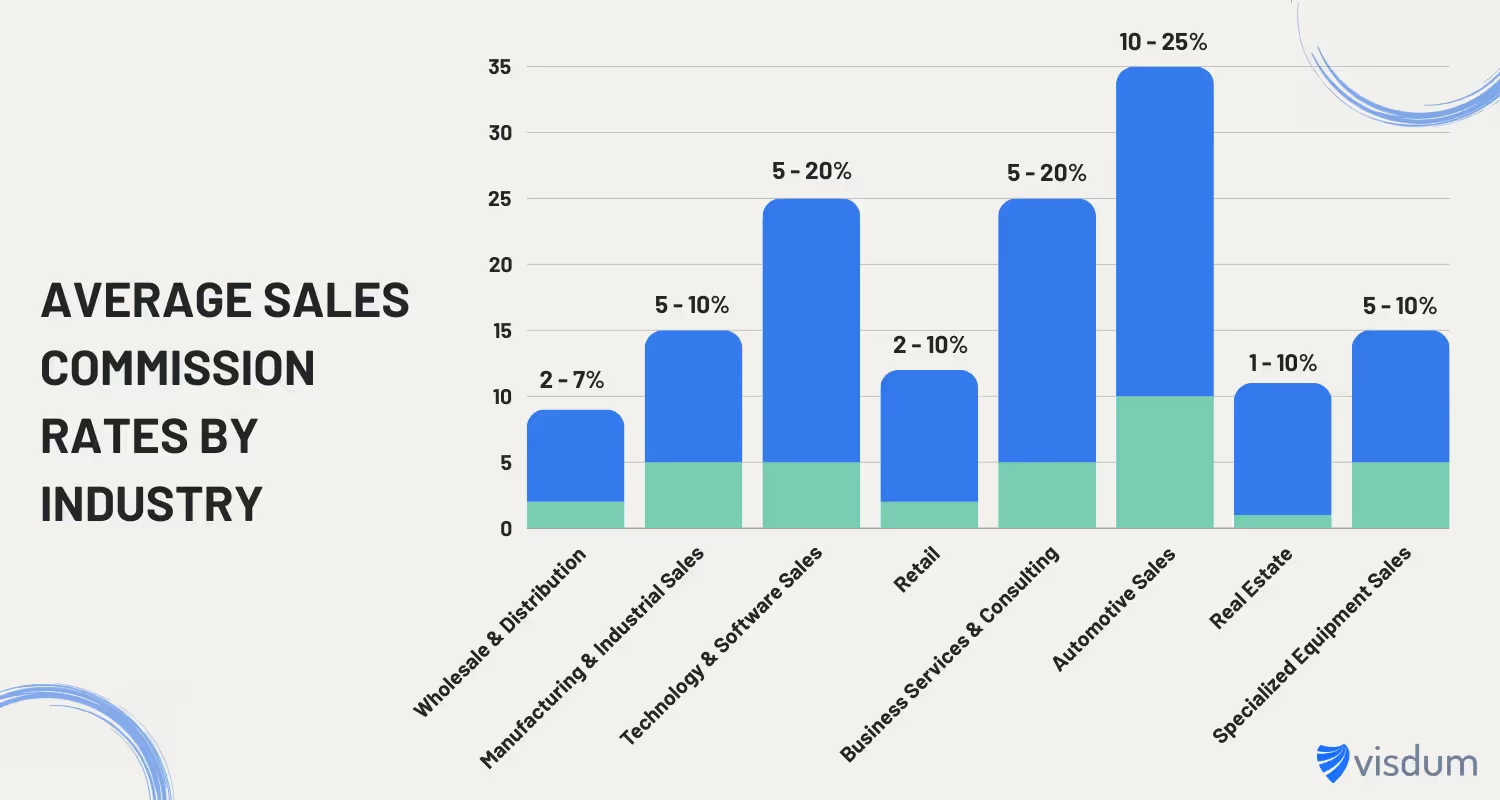
🎯 Role-Based Commission Benchmarks
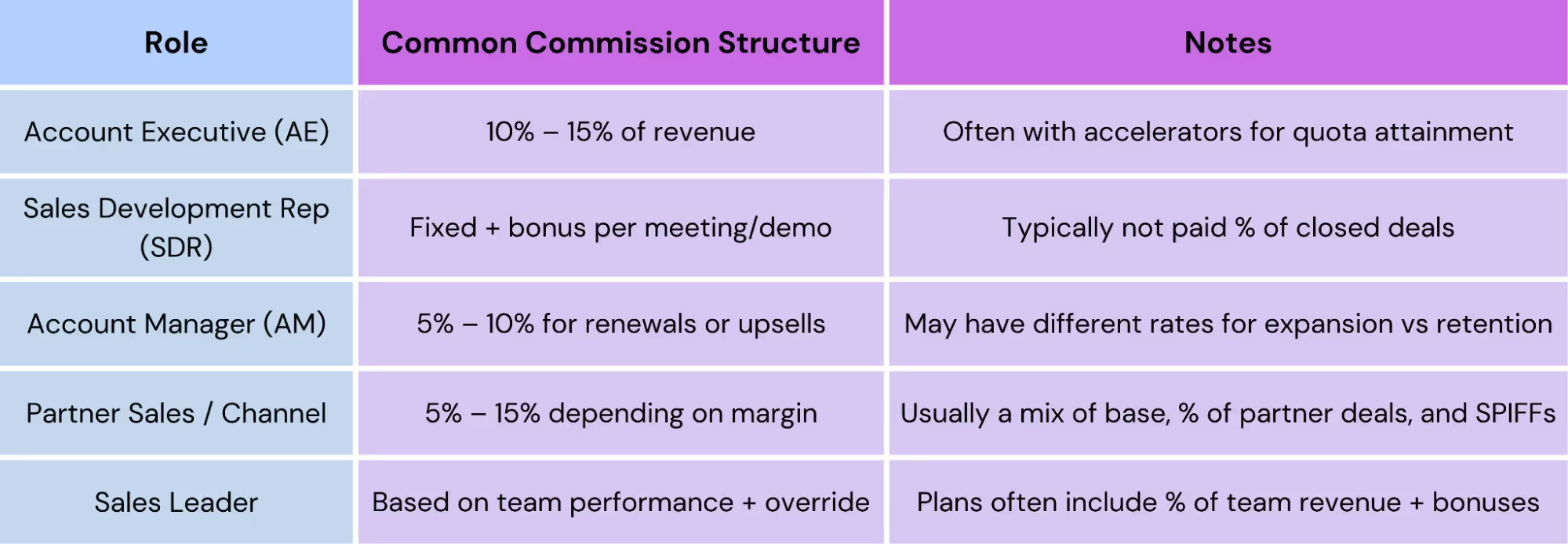
📐 Factors That Influence Commission Rates
- Deal Size
Higher ticket = lower percentage (to control costs) - Margins
Low-margin products = commission based on profit, not revenue - Sales Cycle Length
Longer cycles justify a base salary + lower commission - Sales Motion
Transactional sales = volume-based comp
Consultative/strategic sales = higher % or bonus accelerators - Role Influence
Hunters (AEs) earn more per deal
Farmers (AMs/CSMs) focus on retention and may have bonuses tied to NRR or CSAT
🚩 What’s Too High? What’s Too Low?
- Too high = unsustainable payouts, margin pressure, unhappy finance teams
- Too low = low motivation, high rep attrition, missed revenue goals
If reps are missing quota and making low commissions, your plan might need a redesign — not just a pep talk.
💡 How Software Helps Benchmarking and Plan Adjustments
With Visdum, you can go beyond gut feel and industry averages.
You can:
- Simulate payout curves across different roles
- Model “what-if” scenarios (e.g., what if we change tiers or add an accelerator?)
- Analyze historical data to calibrate fair yet effective commission ranges
- See actual payout-to-quota ratios in real time
Because good commission rates don’t just motivate — they also scale.
Bonus vs. Commission — What’s the Difference and When to Use Each
Sales leaders often use “bonus” and “commission” interchangeably. But they’re not the same — and using the wrong one can backfire fast.
Let’s break it down so you know when to use each — and how to structure them right.
💰 What’s a Commission?
A commission is transactional. It’s a payment directly tied to a specific deal, product sold, or revenue generated. When the rep closes a sale, they earn a percentage or fixed amount.
Example:
- 10% of ACV on every deal closed
- $500 per signed contract
Think of commissions as:
- Ongoing
- Volume-driven
- Embedded in your core compensation plan
They’re great for driving repeatable, scalable actions — especially in new business roles like Account Executives.
🎁 What’s a Bonus?
A bonus is conditional. It’s a one-time reward tied to a defined outcome — not necessarily tied to revenue.
Example:
- $2,000 for hitting 120% of quarterly quota
- $1,000 for 100% renewal rate
- $500 for collecting all contracts within 30 days
Think of bonuses as:
- Strategic nudges
- Behavior shapers
- Periodic incentives
They’re powerful when you want to drive specific actions, milestones, or outcomes that aren’t covered by regular commissions.
🧠 When to Use Bonuses vs. Commissions

⚖️ Can You Use Both?
Absolutely — and you should.
Here’s how high-performing teams often structure it:
- Commission = for core sales activity
- Bonus = for team goals, strategic priorities, or time-sensitive pushes
The trick is clarity. Reps should know:
- What triggers each payment
- How they’re calculated
- When they’ll be paid
🔄 Commission vs Bonus: A Real-World Analogy
Commission is your paycheck for the job you were hired to do.
Bonus is your reward for going above and beyond.
Both matter.
Both motivate.
But they serve different psychological and financial purposes.
👉 Explore: Navigating Bonus Pay vs Commission: How Are They Different?
💼 How Visdum Helps Structure Both
With Visdum, you can manage both commissions and bonuses in one place:
- Set up recurring commission rules
- Layer in bonus criteria for strategic actions or achievements
- Provide reps with a unified dashboard to track everything in real time
- Automate bonus approval workflows and visibility
No more spreadsheets. No more missed payments.
No more “I thought I earned that bonus...” emails.
Uncapped Commissions — The Dream, the Risk, and the Reality
Ask any top-performing rep what they value most, and somewhere near the top of that list you’ll hear:
“Uncapped commissions.”
The freedom to earn as much as they can sell. No ceilings. No limits. Just pure upside.
It sounds like a win-win — reward your best reps, drive higher revenue, and create a competitive edge in hiring.
But like most things in comp planning, the answer isn’t that simple.
🚀 Why Uncapped Commissions Sound So Good
For reps:
- They signal trust and recognition
- They reward hustle without politics
- They’re a magnet for high-performers
For leadership:
- They can drive breakout performance in high-growth phases
- They’re performance-based — no payout unless revenue comes in
- They reduce the need for arbitrary bonuses or SPIFFs
So, what’s the problem?
⚠️ When Uncapped Plans Go Wrong
Uncapped commissions without guardrails can create:
- Budget blowouts — when one mega-deal creates a six-figure payout you didn’t model for
- Margin erosion — when reps discount deeply just to close volume
- Sales channel conflict — when one rep claims credit across regions, roles, or teams
- Bad behavior — like pulling in deals from next quarter just to spike earnings
These aren’t just finance issues — they’re culture issues.
🧭 Should You Offer Uncapped Commissions?
Ask yourself three questions:
- Do you have a cost-of-sale threshold?
Uncapped plans work best when reps can't break your unit economics with a single deal. - Do you have clawbacks, margin floors, and discount guardrails?
If not, you’re inviting abuse. - Are your accelerators well-calibrated?
You can have uncapped plans and still pay less beyond a certain threshold — it’s all in the curve.
🔄 Alternative: Capped Plans with Accelerators
For some companies, it’s safer to offer:
- Accelerators after quota (e.g., 1.2x commission rate after 100%)
- Bonuses at milestones (e.g., $5K at 120%, $10K at 150%)
- Cap removal only on profitable deals (e.g., gross margin > 60%)
This way, you incentivize overperformance without blowing your budget wide open.
For a deep dive, read: What are Uncapped Commissions?
📊 How Visdum Handles Caps, Accelerators, and Guardrails
Commission logic doesn’t live in a spreadsheet.
It lives in every variable deal, every discount code, every custom clause.
Visdum helps you:
- Set up smart caps that auto-adjust by role, product, or margin
- Build tiered accelerators that flex based on performance
- Monitor payout curves in real time — so finance, RevOps, and sales stay aligned
- Prevent overpayments and audit deal logic with click-to-trace accuracy
Sales Commission Compliance — ASC 606, Amortization, and Risk Management
Sales commissions might feel like a sales problem.
But if you’re scaling — or getting audited — they quickly become a finance and compliance problem.
And that’s where ASC 606 comes in.
This accounting standard doesn’t just change how you pay commissions — it changes how you report, amortize, and recognize them in your books.
Ignore it, and you risk misstating revenue, triggering audit red flags, or worse — failing due diligence when raising funding or preparing for acquisition.
Let’s simplify what you need to know.
📘 What Is ASC 606?
ASC 606 is the revenue recognition standard issued by FASB (Financial Accounting Standards Board). It requires companies to recognize revenue and related costs — including sales commissions — in a way that reflects the timing of service delivery.
In short:
If your product or service is delivered over time (e.g., a 12-month SaaS contract), you can’t expense the full commission upfront.
You need to amortize it over the customer’s expected service period.
📉 What Does This Mean for Commissions?
Let’s say:
- Your AE closes a $120,000 SaaS deal (1-year term)
- You pay $12,000 in commission at signing (10%)
Under ASC 606:
- That $12,000 is a deferred cost
- You recognize it monthly (i.e., $1,000/month for 12 months)
If the customer churns after 6 months, you may need to recalculate amortization and reverse part of the cost.
Here is a quick 101 about ASC-606: The Essential Guide to ASC 606 Revenue Recognition in 2025
🧾 Key Terms to Know
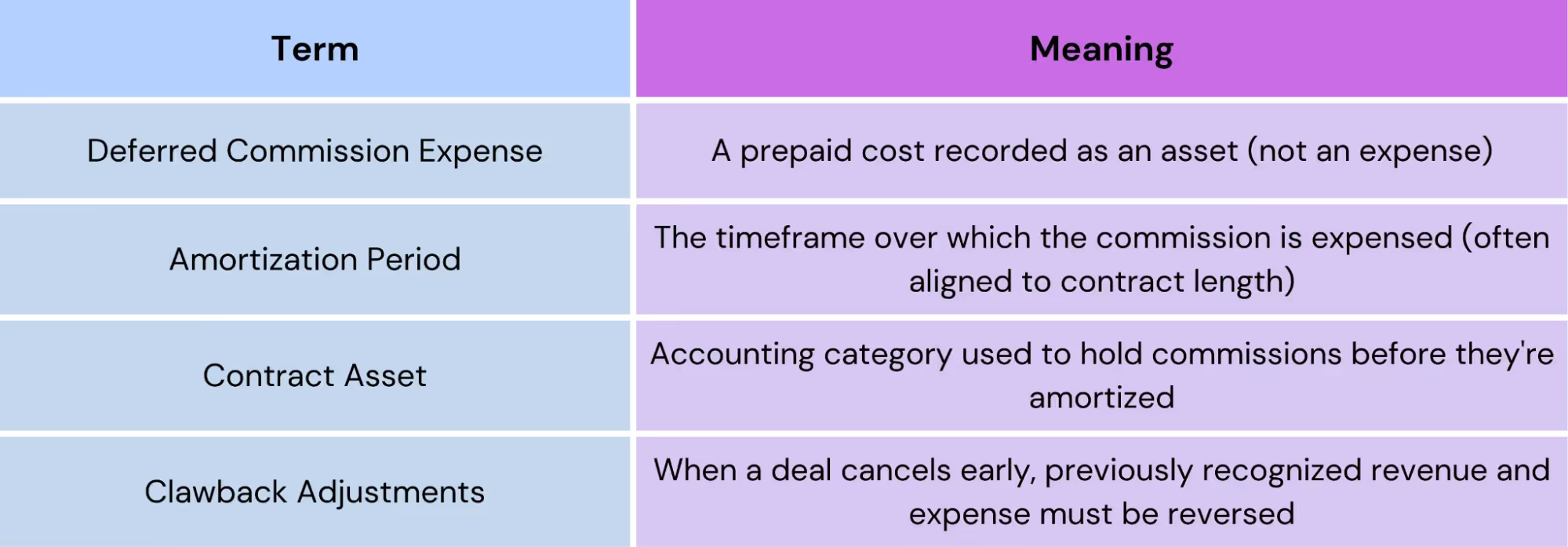
🚨 What Can Go Wrong Without Compliance?
- Overstated earnings (if you expense everything upfront)
- Tax miscalculations
- Failed audits or delayed funding rounds
- CFO scrambling to justify commission costs
It’s not just a reporting issue — it’s a reputational risk.
🔍 How Visdum Makes ASC 606 Easier
Visdum helps automate ASC 606 compliance without turning your finance team into forensic accountants.
You can:
- Tag commission payments by role, product, or plan
- Automate amortization schedules by contract length
- Generate ready-to-audit reports for finance and legal
- Track clawbacks, reversals, and partial cancellations cleanly
Whether you're a Series B startup or a public company preparing for SOX compliance, this level of visibility is not just helpful — it’s critical.

Commission Tracking and Automation — Why Spreadsheets Break, and What to Do Instead
If you’ve ever closed your laptop at 10 PM on a Friday trying to reconcile commission payouts in Excel, you’re not alone.
Most growing sales teams start with spreadsheets.
It makes sense in the beginning: simple team, simple math, simple plan.
But then come:
- Plan variations by role and region
- Accelerators and draw amounts
- Clawbacks, churn, and renewals
- Mid-year product launches and territory changes
- Finance asking for monthly accruals
- Sales reps disputing their numbers
And before you know it, you’re spending 20+ hours a month manually calculating what should be automated in seconds.
Let’s break down why spreadsheets fail — and how to build a smarter system.
❌ 5 Reasons Spreadsheets Don’t Scale
- Human Error
A missed cell reference or manual update can throw off thousands in payouts. - Version Chaos
Which file is the source of truth? “Final_v5_UPDATED_ACTUALS” or “Final_FINAL_USE_THIS_ONE”? - Zero Real-Time Visibility
Reps can’t track earnings mid-cycle. Finance can’t forecast payouts until the last second. - No Audit Trail
When deals change, plans update, or disputes arise — there’s no clear record of why numbers moved. - Not Built for Collaboration
Commission isn’t owned by one person. It spans sales, finance, RevOps, legal, and HR. Spreadsheets can’t support that kind of multi-owner logic.
⚙️ What Automation Fixes
With the right software, you get:
- Real-time calculation based on CRM data (no manual entry)
- Custom rules by role, region, quota, and product
- Transparent payout dashboards for every rep
- Audit logs and automated accrual reports for finance
- Scenario modeling (“What if we added a tier?”) without breaking formulas
In short: less time fixing numbers, more time improving performance.
🔍 How Visdum Replaces the Spreadsheet Headache
Visdum is purpose-built to automate commission plans — especially for fast-growing, high-complexity sales teams.
You can:
- Define rules once, automate forever
- Sync live with Salesforce or HubSpot
- Track deals, clawbacks, accelerators, and bonuses
- Set role-specific plans with logic that evolves as you scale
- Give every rep a real-time earnings dashboard — no more “what’s my payout?” DMs
It’s not just faster. It’s fairer, smarter, and scalable.
TL;DR, Templates, and Tools — Your Sales Commission Playbook for 2025
You’ve made it through the definitive guide on sales commissions.
Now here’s your quick-glance summary, plus tools to help you take action today.
✅ Key Takeaways
- Sales commissions shape behavior. They’re not just payments — they’re your most powerful lever for performance and alignment.
- Commission plans must be clear. If a rep can’t explain their plan in under 2 minutes, it’s too complicated.
- Structure matters. Match commission models to your sales motion: base + commission, tiered, residual, or margin-based — pick what fits.
- Benchmark, but don’t copy blindly. Industry norms are helpful, but your plan must reflect your goals, margins, and motion.
- Compliance isn’t optional. ASC 606 affects how you report commissions. Get ahead of it before your auditor does.
- Automation beats Excel every time. As complexity grows, spreadsheets buckle. A dedicated system creates trust, transparency, and speed.
🛠️ Explore Visdum — The Smart Way to Manage Sales Commissions
Visdum is the sales compensation platform built for SaaS, B2B, and RevOps-led teams that want:
- Accurate, auditable commission tracking
- Custom plans for every role and region
- Real-time dashboards for reps and managers
- Compliance, forecasting, and payout workflows — automated
👉 See how Visdum replaces spreadsheets forever
💬 Still have questions?
We’d love to hear from you.
Whether it’s a plan redesign, audit prep, or tool migration — our team can help.

.webp)

.webp)

